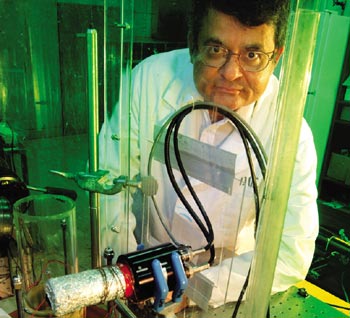NRI Nuclear engineer,
Rusi Taleyarkhan
invented
a bubble fusion reactor- Desktop Nuclear Energy
March 03, 2004
A. Singh
Senior Science WriterRusi Taleyarkhan, Nuclear engineer led the research team at the Oak Ridge National Laboratory in Tennessee that has proposed a small table-top sized nuclear fusion device. Taleyarkhan described the project as true, "tabletop physics, using an apparatus the size of three coffee cups stacked on top of the other." The researchers bombarded millimeter-sized bubbles of deuterated-acetone vapor with sound waves (called acoustic cavitation) that resulted in a burst of subatomic particles called neutrons and the production of tritium, an isotope of hydrogen both evidence of a nuclear fusion reaction. The bubbles reached temperatures of 10 million degrees Kelvin, as hot as the center of the sun. Sonoluminescence light flashes were also observed. The experiment was dubbed "bubble fusion." Richard Lahey Jr. professor at Rensselaer Polytechnic Institute in Troy, New York, co-authored the study. The experiments were conducted by Rusi Taleyarkhan, Colin West, and Jae Seon-Cho. Richard Lahey and Robert Nigmatulin performed the theoretical analysis of the bubble dynamics and the shock-induced pressures, temperatures, and densities in the imploding bubbles. Robert Block, professor emeritus of nuclear engineering at Rensselaer, helped to set up and calibrate a neutron and gamma detection system.

Fusion researcher Rusi Taleyarkhan with the sonoluminescence apparatus at Oak Ridge. (Oak Ridge National Laboratory
A different type of nuclear reaction, called fission, was long ago harnessed to create the atomic bomb and is used in nuclear power plants. Fission splits heavy atoms, such as uranium, to release energy.
Nuclear fusion is a process that joins atoms together. Inside the Sun, for example, hydrogen is fused to create heavier elements. In the process, energy is released. Fusion is the power source of the sun and the stars. The large quantity of energy released by the sun and the stars is the result of the conversion of matter into energy. This occurs when the lightest atom, hydrogen, is heated to very high temperatures forming a special gas called "plasma". In this plasma, hydrogen atoms combine, or "fuse", to form a heavier atom, helium. In the process of fusing, some of the hydrogen involved is converted directly into large amounts of energy.
There are two primary reasons for pursuing fusion research: the furthering of our understanding of the behavior of plasmas that make up most of the known universe, and the creation of a new energy source. Fusion energy would be a renewable energy technology that offers a significant mix of potential advantages. Fusion fuels are abundant and readily available to all nations. Using fusion energy to generate electricity will neither contribute to global warming or air pollution nor will it create long-lived radioactive waste.
The process is known as nuclear fusion, and because it uses readily available elements like hydrogen – as opposed to nuclear fission which uses rare, complex, expensive, and dangerous matter such as uranium and plutonium – scientists have looked at it as a holy grail for cheap, limitless energy. It uses the power of sound to create energy comparable to the inside of stars. In a phenomenon known as isonoluminiscence, a burst of ultrasound causes a bubble in a liquid to collapse and emit a flash of light. It is thought that the gases trapped in the collapsing bubbles could be heated to temperatures hot enough for fusion to occur.
Scientists have understood fusion since the early 1900s, and for many decades they have tried unsuccessfully to recreate this process in labs. Commercial fusion could solve the world's power woes, some scientists have long claimed, and it would do so safely, with little or no harmful byproducts like the radioactive waste that comes from fission.
Many schemes have been developed, from using magnetism to lasers to create high-speed, high-temperature collisions among atoms. Other so-called "cold fusion" efforts were widely reported but never reproduced, and therefore scientists considered them flawed.